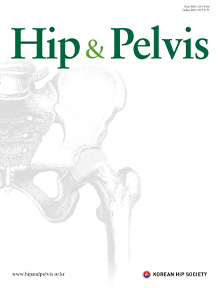Quick links
Related article in
-
Review ArticleJune 1, 2010
 0
0
 66
66
 11
11
Treatment of Infected Total Hip Arthroplasty
Han-Seok Ko, MD, Woo-Han Bae, MD
J Korean Hip Soc 2010; 22(2): 104-110AbstractDeep infection after total hip arthroplasty is one of the most serious post operative complications. Treatment of infection of the hip joint can be made very difficult by poor response to antibiotic therapy. Infection rates of total hip arthroplasty have decreased due to prophylactic antibiotics, sterilization of surgical instruments, cleaner operation environments, Improvement of surgical methods and proper patient selection. Recently, post operative infection rates of primary or revision arthroplasties were reported to still be as high as 1% to 2%. Therefore, the aim of this article is to review the recent literature and to evaluate the cause, environment diagnosis and treatment of infection after total hip arthroplasty. -
Case ReportSeptember 1, 2011
 0
0
 59
59
 12
12
Trochanteroplasty for the Treatment of Uncontrolled Infected Total Hip Arthroplasty - A Case Report -
Kyung Soon Park, MD, Taek Rim Yoon, MD, Jae Young Moon, MD, Qin Sheng Hu, MD
J Korean Hip Soc 2011; 23(3): 221-224Trochanteroplasty is a salvage procedure that is normally performed in septic infant hips. The procedure can provide a stable, painless, functional hip, and reduce any leg-length discrepancy. The authors describe a case of revisional total hip arthopalsty performed on a 65 year-old male patient 4 years after trochanteroplasty for an uncontrolled infection after total hip arthoplasty. The available literature on trochanteroplasty was reviewed. The authors provide a feasible strategy for treating adult hip infections with deficient bone stock in the proximal femur. -
Original ArticleMarch 1, 2008
 0
0
 57
57
 12
12
Treatment of Infected Total Hip Arthroplasty
Joong-Myung Lee, M.D., Hee-Tae Nam, M.D.
J Korean Hip Soc 2008; 20(1): 27-34AbstractPurpose: To analyze the effectiveness of a two-stage revision surgery for an infected total hip arthroplasty.
Materials and Methods: Between 1988 and 2005, twenty-four patients (24 hips, 18 males, 6 females) with documented infection of total hip arthroplasty were reviewed and followed for at least two years postoperatively. The preoperative and postoperative clinical and radiologic findings and blood laboratory work were compared. Eight arthroplasty cases were performed through retention of the femoral stem and removal of the acetabular cup with cementing by impregnated antibiotics in the first stage of the operation, and subsequent acetabular cup revision in the second stage of the operation.
Results: After the first stage of the operation, infectious organisms were cultured in 19 patients, and isolated Staphylococcus aureus was cultured in 14 patients. The mean follow-up period was 8.2 years, and the average Harris hip score improved to 88.4 points at last follow-up. Radiologic osteolysis was noted in 5 cases, and possible loosening was demonstrated in 1 case. The erythrocyte sediment rate (mm/hr) and C-reactive protein (mg/L) were 43.8/14.2 preoperatively and 17.9/8.3 postoperatively. There were 2 recurrences of infection, for an eradication rate of 91.7% (22 of 24).
Conclusion: Two-stage revision for an infected total hip arthroplasty proved to be an excellent method with a high eradication rate.
- 1

Vol.36 No.1
Mar 01, 2024, pp. 1~75
Most Keyword
?
What is Most Keyword?
- It is most registrated keyword in articles at this journal during for 2 years.
Most View
-
Pathophysiology and Treatment of Gout Arthritis; including Gout Arthritis of Hip Joint: A Literature Review
Yonghan Cha, MD
Hip Pelvis 2024; 36(1): 1-11 , Jongwon Lee, MD
, Jongwon Lee, MD  , Wonsik Choy, MD
, Wonsik Choy, MD  , Jae Sun Lee, PhD*,†
, Jae Sun Lee, PhD*,†  , Hyun Hee Lee, MD‡
, Hyun Hee Lee, MD‡  , Dong-Sik Chae, MD‡
, Dong-Sik Chae, MD‡ 
-
Treatment of Osteoporosis after Hip Fracture: Survey of the Korean Hip Society
Jung-Wee Park, MD
Hip Pelvis 2024; 36(1): 62-69 , Je-Hyun Yoo, MD*
, Je-Hyun Yoo, MD*  , Young-Kyun Lee, MD
, Young-Kyun Lee, MD  , Jong-Seok Park, MD†
, Jong-Seok Park, MD†  , Ye-Yeon Won, MD‡
, Ye-Yeon Won, MD‡ 
Editorial Office
Laboratory tests performed in hip fracture patients. CTX: carboxy-terminal telopeptide of collagen I, PTH: parathyroid hormone, P1NP: procollagen type I N propeptide, U/A: urinalysis.|@|~(^,^)~|@|First-line treatment option for osteoporosis in hip fracture patients. BP: bisphosphonate, PTH: parathyroid hormone, SERM: selective estrogen receptor modulator.|@|~(^,^)~|@|Osteoporosis medication in patients with rebound phenomenon after cessation of denosumab. Ca+Vit. D: calcium and vitamin D, PTH: parathyroid hormone, SERM: selective estrogen receptor modulator.|@|~(^,^)~|@|The most important recognized factor for atypical femoral fracture.|@|~(^,^)~|@|Preferred osteoporosis medications after cessation of bisphosphonate in patients with atypical femoral fracture. PTH: parathyroid hormone, Ca+Vit. D: calcium and vitamin D, SERM: selective estrogen receptor modulator.|@|~(^,^)~|@|Preferred osteoporosis medications in patients with high-risk of atypical femoral fracture. Ca+Vit. D: calcium and vitamin D, SERM: selective estrogen receptor modulator, PTH: parathyroid hormone.
Hip Pelvis 2024;36:62~69 https://doi.org/10.5371/hp.2024.36.1.62
© H&P
© 2024. The Korean Hip Society. Powered by INFOrang Co., Ltd




 Cite
Cite PDF
PDF



